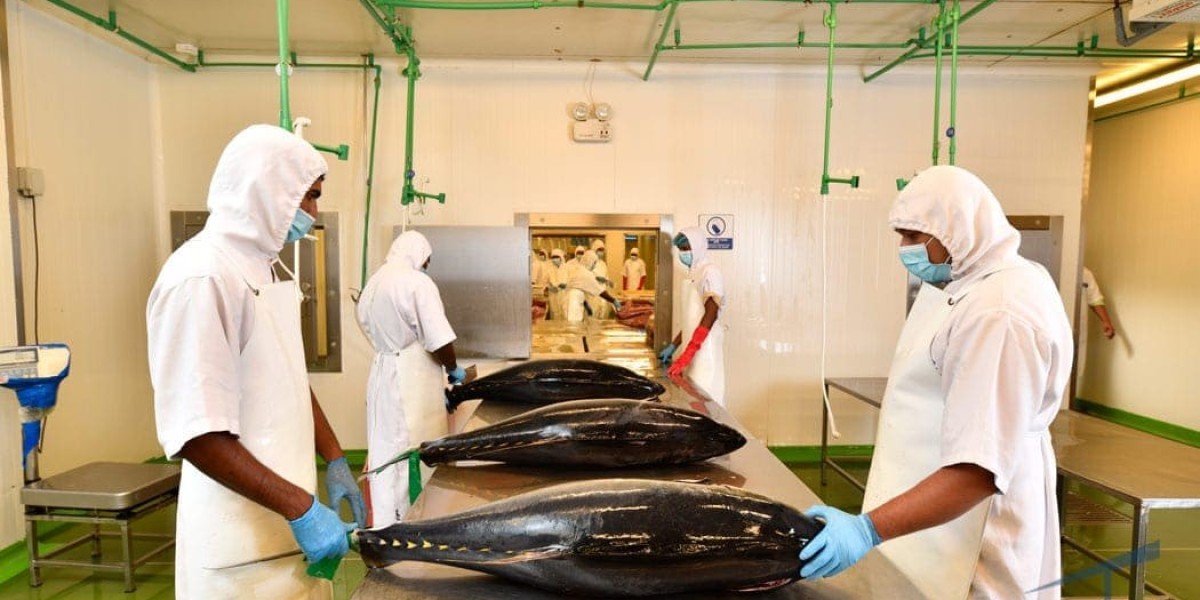Not all tuna fish are the same. According to fresh tuna suppliers, there are several different species of tuna, each with unique characteristics, flavours, and uses. Here are some of the most common types of tuna available:
- Bluefin Tuna (Thunnus thynnus)
Characteristics: Bluefin tuna is known for its rich flavour and high fat content. It has a dark red flesh and is highly prized, especially in sushi and sashimi.
Uses: Often used in high-end sushi restaurants. The toro (fatty belly meat) is especially sought after.
Regions: Found in the Atlantic and Pacific Oceans.
- Yellowfin Tuna (Thunnus albacares)
Characteristics: Yellowfin tuna has a milder flavour and a firm texture. The flesh is pink to deep red.
Uses: Commonly used in sushi, sashimi, grilling, and searing.
Regions: Found in tropical and subtropical waters around the world, this is one of the best Indian Ocean tuna found on the market, and available with the best yellowfin tuna exporters.
- Albacore Tuna (Thunnus alalunga)
Characteristics: Albacore tuna has a lighter, whiter flesh and a milder taste compared to other tuna species. It is often referred to as "white tuna."
Uses: Commonly canned and used in salads and sandwiches. Also used in sushi as "shiro maguro."
Regions: Found in temperate and tropical waters around the world.
- Bigeye Tuna (Thunnus obesus)
Characteristics: Bigeye tuna has a high-fat content and a robust flavour, similar to bluefin. The flesh is a deep red.
Uses: Often used in sushi and sashimi. It is also good for grilling and searing.
Regions: Found in tropical and temperate oceans worldwide.
- Skipjack Tuna (Katsuwonus pelamis)
Characteristics: Skipjack tuna has a stronger flavour and darker flesh compared to albacore. It is the most commonly canned tuna.
Uses: Mostly used for canning and in processed products like tuna salads and casseroles.
Regions: Found in tropical and warm-temperate waters around the world.
- Bonito (Sarda spp.)
Characteristics: Bonito is related to tuna but is smaller and has a stronger, more pronounced flavour. The flesh is darker and firmer.
Uses: Often used in Mediterranean cuisine and for making bonito flakes (katsuobushi) used in Japanese cuisine.
Regions: Found in temperate and tropical waters, especially in the Atlantic and Mediterranean.
According to fish processing companies, each type of tuna has its own culinary uses and preferences, making them suitable for different dishes and preparations.
Why is it that all tuna is not the same?
Tuna species differ due to several factors, including their biological and ecological characteristics, which influence their appearance, taste, texture, and culinary uses. Here are the key reasons why all tuna is not the same:
- Species Differences:
- Genetics: Different species of tuna have unique genetic makeups, resulting in variations in size, colour, taste, and fat content.
- Morphology: The physical structure, such as body shape and muscle composition, varies among species, affecting the texture and quality of the meat.
- Habitat and Diet:
- Habitat: Tuna species inhabit different regions and depths of the ocean, from tropical to temperate waters, which influences their diet and behaviour.
- Diet: The type of prey available in their habitat affects the flavour and fat content of the tuna. For example, tuna feeding on high-fat prey will have higher fat content and richer flavour.
- Metabolism and Fat Content:
- Fat Content: Species like bluefin and bigeye tuna have higher fat content, resulting in richer, more flavourful meat. In contrast, species like skipjack and albacore have lower fat content and a milder taste.
- Metabolism: The metabolic rate of different tuna species affects the texture and taste of the meat. Higher metabolic rates often result in firmer, more muscular flesh.
- Fishing Methods and Handling:
- Fishing Techniques: Different species are targeted using various fishing methods, such as longlining, purse seining, or pole-and-line fishing, which can impact the quality and sustainability of the catch.
- Post-Harvest Handling: The way tuna is processed and handled after being caught, including chilling, freezing, and storage methods, can affect its quality and taste.
- Market Demand and Culinary Uses:
- Market Preferences: Different markets and cultures have preferences for certain types of tuna. For example, bluefin tuna is highly prized in Japanese cuisine for sushi and sashimi, while skipjack tuna is commonly used in canned products in Western countries.
- Culinary Applications: Each tuna species is suited to specific culinary applications due to its flavour, texture, and fat content. This diversity allows for a wide range of dishes, from raw preparations like sushi to cooked dishes like grilled tuna steaks and canned tuna salads.
These factors collectively contribute to the diversity in tuna species, making each type unique in its characteristics and culinary uses.
How to ensure that you are buying fresh and sustainably caught tuna
To ensure that you are buying fresh and sustainably caught tuna, consider the following tips:
For Fresh Tuna:
- Check the Appearance:
- Colour: Fresh tuna should have a vibrant, rich colour. For example, bluefin and bigeye tuna should have deep red flesh, while albacore will be lighter.
- Texture: The flesh should be firm and resilient, not mushy or slimy. It should also have a glossy appearance.
- Smell: Fresh tuna should have a clean, ocean-like smell. Avoid tuna with a strong fishy or ammonia-like odour.
- Inspect the Packaging:
- Date: Look for a "catch" or "sell by" date to ensure freshness. Tuna should be as close to this date as possible if buying pre-packaged.
- Storage: Ensure that the tuna is stored at the correct temperature, ideally on ice or in a refrigerated case.
- Ask the Seller:
- Source: Inquire about the source of the tuna. A reputable seller should be able to provide information about where and how the tuna was caught.
- Handling: Ask about how the tuna has been handled and stored to ensure it has been kept in optimal conditions.
For Sustainably Caught Tuna:
- Look for Certifications:
- MSC (Marine Stewardship Council): This certification indicates that the tuna was caught from a fishery that meets sustainability standards.
- FIP (Fishery Improvement Project): Some tuna fisheries participate in improvement projects to address sustainability issues. Look for FIP participation if MSC is not available.
- Check the Label:
- Eco-Labels: Look for eco-labels or sustainability certifications on canned tuna or packaging. These labels often indicate that the product meets environmental and ethical standards.
- Research Brands:
- Sustainable Brands: Some brands are known for their commitment to sustainable fishing practices. Research brands and check their sustainability reports or commitments.
- Avoid Overfished Species:
- Know the Species: Some tuna species, like bluefin, are overfished and critically endangered. Choose species that are more sustainable, like skipjack or albacore, when possible.
- Use Resources:
- Guides and Apps: Utilise sustainability guides or apps like the Seafood Watch app from the Monterey Bay Aquarium, which provides information on which tuna products are environmentally friendly.
These guidelines can help you make more informed choices and contribute to the sustainability of tuna fisheries while enjoying high-quality, fresh tuna.







